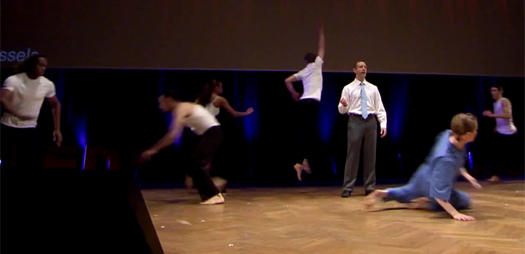Once you’ve watched John Bohannon’s talk and dance performance from TEDxBrussels (watch it on TED.com), you may have the same question the TED Blog had: How in the world did you do that? So we asked, and here’s what he sent us in reply:
A Modest Proposal
For Preventing the Artists of the United States of America From Being a Burden to Their Parents or Country, and For Making Them Beneficial to The Public
Early in the summer this year, I got a call from Walter de Brouwer, the curator of TEDxBrussels. He loved the Dance Your PhD contest and wanted me to come give a talk about it. I was traveling in Europe so we met in London. Over drinks, I told him that I didn’t want to actually screen the dance videos during my talk. I didn’t want to use any multimedia at all. Instead, I wanted to use live dancers on stage in lieu of powerpoint, demonstrating the essence of Dance Your PhD. He loved the idea.
Over the summer, I worked with Black Label Movement, a dance company based in Minneapolis led by Carl Flink. We had a shoestring budget, not even enough to get all the dancers to Brussels. So we had to create the dance and rehearse in Minneapolis in our spare time for free. Then we hired 6 Brussels-based dancers and arrived in Brussels 10 days early to rehearse with them. I’m amazed we pulled it off, but Carl wasn’t surprised. Professional dancers find this kind of pressure routine.
The piece changed drastically over the course of its creation. As I got to know the dancers and see how they struggled to make ends meet, especially when injuries occur without healthcare coverage, my mood darkened. What began as a small piece of optimistic theater about science turned into a satire about the status of artists in the US. As inspiration, I looked back to Jonathan Swift’s 1729 essay, “A Modest Proposal,” It was a masterpiece of political satire that proposed a seemingly rational solution to the problem of the poor in Ireland: They should sell their babies as food, generating much-needed income and reducing their population in one stroke. It was a reply to some of the brutal utilitarian policies being discussed at the time by the aristocracy. Where you hear antique language in my presentation, I am quoting Swift verbatim.
So many people worked for free or nearly free to make this possible. Support from the Institute for Advanced Studies at the University of Minnesota was crucial. These are the full credits:
Choreographer: Carl Flink and Edward Oroyan
Dancers: Jessica Ehlert, Brian Godbout, Stephanie Laager, Edward Oroyan, Nelle Hens, Camille Prieux, Mariel Blaise, Gapson Nenaks, David Zagari & Marcio Canabarro
Music: Greg Brosofske

Comments (7)
Pingback: El arte de presentar » Danza o canta tu presentación
Pingback: Ditch Powerpoint and Dance Your Presentations | The [non]billable hour
Pingback: Science and Art | Elemental Arts : Pomona College
Pingback: A Proposal to Use Dancers Instead of PowerPoint
Pingback: Top Ten Tuesday
Pingback: Danza o canta tu presentación « El Arte de Presentar